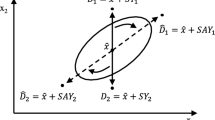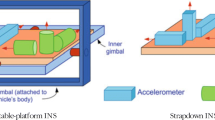Abstract
Vertical layered space-time codes have demonstrated the enormous potential to accommodate rapid flow data. Thus far, vertical layered space-time codes assumed that perfect estimates of current channel fading conditions are available at the receiver. However, increasing the number of transmit antennas increases the required training interval and reduces the available time in which data may be transmitted before the fading coefficients change. In this paper, a vertical layered space-time code is proposed. By applying the subspace method to the layered space-time code, the symbols can be detected without training symbols and channel estimates at the transmitter or the receiver. Monte Carlo simulations show that performance can approach that of the detection method with the knowledge of the channel.
Similar content being viewed by others
References
G. J. Foschini, M. J. Gans, On limits of wireless communication in a fading environment when using multiple antennas, Wireless Personal Commun., 6(1998)3, 311–335.
G. J. Foschini, Layered space-time architecture for wireless communication in a fading environment when using multi-element antennas, Bell Labs Tech. J., (1996) Autumn, 41–59.
B. L. Hughes, Differential space-time modulation, IEEE Trans. on Inform. Theory, 46(2000)7, 2567–2578.
H. Liu, G. Xu, Closed-form blind symbol estimation in digital communications, IEEE Trans. on Signal Processing, 43(1995)11, 2714–2723.
H. Liu, G. Xu, A subspace method for signature waveform estimation in synchronous CDMA systems, IEEE Trans. on Commun., 44(1996)10, 1346–1354.
S. Zhou, B. Muquet, G. B. Giannakis, Subspace-based (semi-) blind channel estimation for block precoded space-time OFDM, IEEE Trans. on Signal Processing., 50(2002)5, 1215–1228.
Q. Yin, R. Newcomb, L. Zou, Estimating 2-D angle of arrival via two parallel linear array, Proc. IEEE ICASSP’89, Glasgow, Scotland, May 1989, 2803–2806.
P. W. Wolniansky, G. J. Foschini, G. D. Golden, R. A. Valenzuela, V-BLAST: An architecture for realizing very high data rates over the rich-scattering wireless channel, Proc. URSI ISSSE’98, Pisa, Italy, 1998, 295–300.
G. J. Foschini, G. D. Golden, Simplified processing for high spectral efficiency wireless communication employing multi-element arrays, IEEE J. on Select. Areas Commun., 17(1999)11, 1841–1852.
B. Jiang, The smart antenna system based on space-time channel estimation, Ph. D. Dissertation, Xi’an Jiaotong University, 2001.
D. Xiu, J. M. Kahn, Layered space-time codes for wireless communications using multiple transmit antennas, Proc. IEEE ICC’99, Vancouver, BC, Canada, 1999, 436–440.
Author information
Authors and Affiliations
Additional information
Partially supported by the National Natural Sciences Foundation (No.69872029) and the Research Fund for Doctoral Program of Higher Education (No.1999069808) of China
About this article
Cite this article
Zhao, Z., Yin, Q., Zhang, H. et al. A vertical layered space-time code and its closed-form blind symbol detection. J. of Electron.(China) 20, 102–109 (2003). https://doi.org/10.1007/s11767-003-0004-z
Received:
Revised:
Issue Date:
DOI: https://doi.org/10.1007/s11767-003-0004-z




